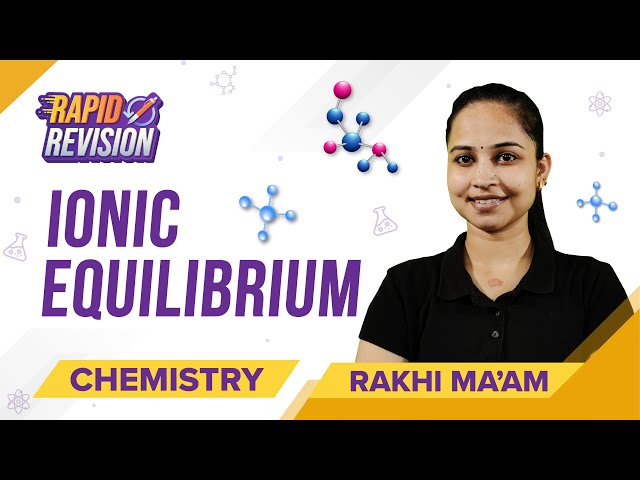In ionic equilibrium, the ionic substance dissociates into its ions in polar solvents. The ions formed are always in equilibrium with their undissociated solute in the solution.
⇒ Representation of Ionic Equilibrium: Xa Yb ⇌ aXb+ + bYa-
Introduction to Ionic Equilibrium
Reactants and products coexist in equilibrium so that reactant conversion to product is always less than 100%. Equilibrium reactions may involve the decomposition of a covalent (non-polar) reactant or the ionization of ionic compounds into their ions in polar solvents.
In this section, we will learn about the ionic equilibrium in ionic solutions. Substances in ionic equilibrium can be classified into two categories on the basis of their ability to conduct electricity.
Non-Electrolytes
These are substances that consist of molecules that bear no electric charge, do not dissociate into their constituent ions, and thus do not conduct electricity in their aqueous solution or molten state. For example, sugar solution.
Electrolytes
These are substances that dissociate into their constituent ions in their aqueous solution, and thus conduct electricity in their aqueous solutions or molten state. For example, salt solution, acid solution, base solution, etc.
Electrolytes in ionic equilibrium can be further classified into strong and weak electrolytes.
Strong electrolytes are substances that, upon dissociation in their ionic solution, ionize completely, while in the case of weak electrolytes, the dissociation is partial in nature.
For example, NaCl undergoes complete ionization in its aqueous solution to render sodium ions (Na+) and chloride (Cl–) ions, whereas acetic acid undergoes partial ionization to render some amount of acetate ions (CH3COO–) and hydrogen (H+) ions.
- In the case of a strong electrolyte, the dissociation reaction is said to be complete, thus moving in the forward direction only, whereas, in the case of a weak electrolyte, the reaction is said to be reversible in nature.
- In the case of the weak electrolyte, the equilibrium is established between the ions and the unionized molecules, which can be termed ionic equilibrium. The same can be understood in detail with the following example.
⇒ Also Read:
Ostwald’s Dilution Law: Degree of Dissociation
Ostwald’s dilution law is the application of the law of mass action to weak electrolytes in solution.
A binary electrolyte AB dissociates into A+ and B– ions.
AB ⇌ A+ + B–
(i) For very weak electrolytes, since α <<< 1, (1 – α) = 1
∴
(ii) Concentration of any ion = Cα = √CK = √K/V
The degree of ionization increases on dilution. Thus, the degree of dissociation of a weak electrolyte is proportional to the square root of dilution.
Limitations of Ostwald’s Dilution Law
The law holds good only for weak electrolytes and fails completely in the case of strong electrolytes.
Ionic Equilibrium Key Points Discussion – Part 1

Ionic Equilibrium Key Points Discussion – Part 2

Ionic Equilibrium Formulas
It becomes necessary to know what fraction of the initial amount of the reactants is converted into products at equilibrium.
The fraction of the initial molecules that are converted at equilibrium is called the degree of dissociation/ionization.
Degree of dissociation or ionization = α = (Number of reactant molecules dissociated\ionized at the start)/(Number of reactant molecules at the start).
The degree of dissociation in ionic equilibrium can be expressed in percentage.
% Degree of dissociation or ionization = α = (Number of reactant molecules dissociated or ionized at the start)/(Number of reactant molecules at the start) × 100
Degree of Ionization
The degree of ionization depends on the following:
- Nature of the electrolyte: Strong, weak, insoluble
- Nature of the solvent: High dielectric solvents increase ionization
- Dilution: Larger the dilution higher the ionization
- Temperature: Higher the temperature, the larger the ionization
- The presence of common ions decreases the ionization of the weak electrolyte
Dissociation of Ionic Compounds in Polar Solvents
Ionic compounds dissolve in polar solvents with ionization into cations and anions.
The ionized ions are in equilibrium with the un-dissociated molecules.
AxBy ⇌ xAy+ + yBx-
Ionic Solids in Solutions
Strong electrolytes (α ≈100% ionization), weak electrolytes (α ≈ 10% ionization), and sparingly soluble (α ≈100% ionization)
Example: HCl, NaOH, Salts NH4OH, Organic Acids AgCl, BaSO4
Ionization of Weak Electrolytes
In infinite dilution, all electrolytes are fully ionized. In a concentrated solution, weak electrolytes exist in equilibrium with their unionized molecules. Concentrations of the ions are important in many practical situations like acid-base solubility and conductance of the solution.
Common Ion Effect on Degree of Dissociation
Weak electrolytes are poorly ionized in an aqueous solution. Their ionization may further be reduced if one of the ions is present from another source. This is called a common ion effect.
i) Ammonium hydroxide is a weak base. When adding ammonium chloride (a salt), ammonium ions from it will make the ammonium ions combine with the hydroxide to form unionised ammonium hydroxide.
NH4Cl → NH4+ + Cl–
NH4OH ⇌ NH4+ + OH–
ii) In the base hydrolysis of oil, the sodium salt of the fatty acid (soap) is in a dissolved state.
When sodium chloride salt is added, the concentration of Na+ ions increases considerably.
CnH2n+1 + COONa ⇌ CnH2n+1 COO– + Na+
NaCl ⇌ Na+ + Cl–
Hence, the ionic product [CnH2n+1COO–] [Na+] exceeds the solubility product of soap and, therefore, soap precipitates out from the solution. This is called salting out of soap.
(iii) Manufacture of sodium bicarbonate (baking soda)
In Solvay’s soda process. The CO2 gas is passed through ammonical brine to precipitate out NaHCO3.
NH4OH + CO2 → NH4HCO3
NH4HCO3 + NaCl → NH4HCO3 + NH4Cl
NaHCO3 is precipitated first because of its lower solubility product as compared to those of NH4Cl, NH3HCO3 and NaCl.
⇒ Check:
Video Lessons
Ionic Equilibrium Revision and Previous Years’ Questions

Ionic Equilibrium Most Important JEE Questions

Ionic Equilibrium – Important Topics

Ionic Equilibrium – Important Questions

Ionic Equilibrium Rapid Revision

Ionic Equilibrium


Comments